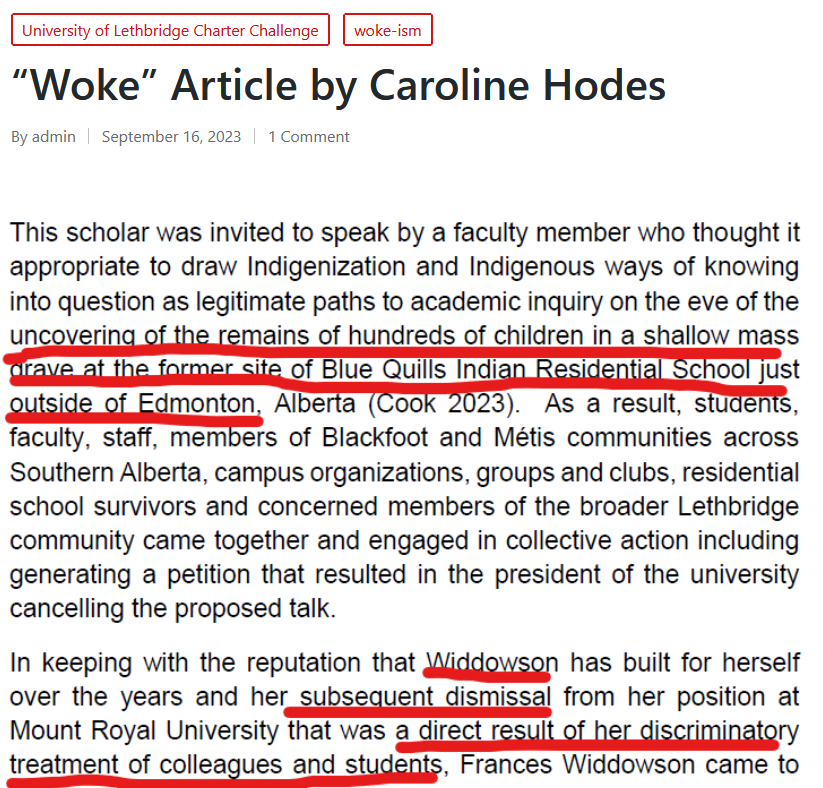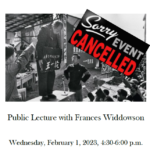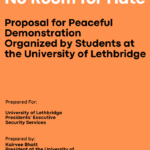From: Nina Green [redacted]
Subject: What’s going on with the accidental excavation since 2004 of 100 graves at the Sacred Heart parish cemetery near the former Blue Quills Indian Residential School?
Date: February 15, 2024 at 7:03:11 PM PST
What’s going on with the accidental excavation since 2004 of 100 graves at the Sacred Heart parish cemetery near the former Blue Quills Indian Residential School? That’s a very good question. Let’s look into it.
The Blue Quills Indian Residential School on the Saddle Lake Reserve (1898-1931) By way of background, the Blue Quills Indian Residential School operated at three different sites – Lac La Biche (until 1898), the Saddle Lake reserve (1898-1931), and a location near St Paul (from 1931 until the school closed).Press conferences held in 2022, 2023,
and 2024 by theAcimowin Opaspiw Society (AOS), which was formed under the Canada Not-for-profit Corporations Act on 16 June 2021 as the Acimowin Opaspiw (Survivors Stories) Society to represent survivors of the former Blue Quills Indian Residential School and their descendants, were concerned with the second site, which was in operation from 1898-1931 on what is now the Saddle Lake Cree Nation reserve.The abandoned residential school building on the Saddle Lake reserve was burned to the ground by former students after the school moved to St Paul in 1931, and its location was lost. In fact, according to Leah Redcrow, CEO of the Society, Band members had completely forgotten that there ever was a residential school at Saddle Lake until they were told about it in 2021.While the residential school was in operation during the years 1898-1931, it was situated near the Roman Catholic Mission, which included the Sacred Heart parish church (first built in 1893, five year earlier than the school), and its cemetery.It’s important to note that the Sacred Heart cemetery was part of the Roman Catholic Mission, and was never a residential school cemetery. It was always the parish cemetery of the Sacred Heart church on the reserve where adults, children and infants alike have been buried for 130 years. As Chief Sophie Pierre remarked on 2 July 2021, one can’t jump to the conclusion that a cemetery was a residential school cemetery merely because there was a residential school in the vicinity:
Former chief Sophie Pierre told Global News “there’s no discovery, we knew it was there, it’s a graveyard.”
“The fact there are graves inside a graveyard shouldn’t be a surprise to anyone.” . . .
“To just assume that every unmarked grave inside a graveyard is already tied to a residential school, we’ve got to be a little bit more respectful of our people who are buried in our graveyards,” Pierre said.
Even today, members of the Saddle Lake Band are still being buried in the Sacred Heart parish cemetery. Find A Grave has documented 635 burials of named individuals, 54% of them with photographs of headstones and grave markers. The vast majority of burials are very recent, dating from long after the Blue Quills Indian Residential school had relocated to St Paul in 1931; in fact, in many cases these burials date from after the residential school system in Canada had ended. Some of the burials are even of white adults from the area (Adam, Anna and Anton Podloski, for example).As has happened at cemeteries on reserves across Canada, wooden grave markers have deteriorated over the years, and the Saddle Lake Band long ago lost track of the original boundaries of the Sacred Heart parish cemetery, just as they lost track of the location, and in fact of the very existence, of the Blue Quills Indian Residential School. The result is that for almost two decades since 2004, and indeed as recently as December 2021, the Band has been accidentally digging up old unmarked graves while looking for places to bury newly-deceased Band members. According to the Acimowin Opaspiw Society, this has now happened about 100 times since Jason Whiskeyjack accidentally dug up a grave in 2004.
Why did the Band not immediately close the cemetery to new burials in 2004, build a fence around it to mark the boundaries, and open a new cemetery elsewhere on the reserve?No answer has been provided by the Saddle Lake Band to this obvious question: after Jason Whiskeyjack uncovered skeletal remains in the Sacred Heart parish cemetery in 2004, why did the Band not immediately close the parish cemetery to new burials, build a fence around it to mark its boundaries, and open a new cemetery elsewhere on the reserve?Even more to the point, why did the Band not immediately close the Sacred Heart parish cemetery to new burials after Eric Large accidentally unearthed skeletal remains as recently as 2017? We know from Eric Large himself what happened in 2017. On Tuesday, 17 May 2022, the Acimowin Opaspiw Society held a press conference which resulted in two videos, one posted by Global News, another by APTN News (copies of transcripts attached) in which Eric Large, by that time the Society’s lead investigator, and Jason Whiskeyjack, spoke of unearthing human skeletal remains in the Sacred Heart parish cemetery while excavating new gravesites. The word ‘excavating’ in these videos indicates that the work was done by machine, which of course entails the possibility that several unmarked graves in the parish cemetery could have been broken into at once, intermingling the skeletal remains.In the video posted by Global News, Large said that in 2017, while excavating new gravesites, he unearthed ‘small bones’ which he could not identify as specific skeletal body parts: Kim Smith (reporter): Looking back, Eric Large says he simply didn’t know what to do. Large is a residential school survivor. In 2017 he was doing work excavating new gravesites at a community cemetery when he uncovered unexpected human remains.Eric Large: I came across uh some small bones. I, I couldn’t tell what they were, I mean from what parts of the body.Kim Smith: For almost 20 years, since around 2004, members of the Saddle Lake Cree Nation northeast of Edmonton have been making similar discoveries. In the APTN News video, Large also said that while burying recently deceased Band members, he had unearthed a small rib cage attached to a spine and a small skull, and Jason Whiskeyjack spoke of ‘hitting a lot of these graves’: Chris Stewart (reporter): The two men say that they have come across remains while burying current members who have passed away.Eric Large: I came across a small rib cage attached to a spine, and then more infilling, I came across a small skull.Jason Whiskeyjack: When I hit a lot of these graves, you know, there’s no supports for us.
Nothing was done about these accidental excavations in the Sacred Heart parish cemetery until after the false Kamloops claim in 2021Instead of immediately closing the Sacred Heart parish cemetery to new burials, the Band did nothing, and for almost two decades skeletal remains continued to be unearthed in the parish cemetery when new graves were being excavated until 2021, when the Kamloops Band shocked the world with the false claim that it had found ‘the remains of 215 children’ in the apple orchard area on which it had built its Heritage Park.The Acimowin Opaspiw Society was incorporated on 16 June 2021, only three weeks after the false Kamloops claim, and the Society quickly set about persuading the Catholic Church to grant it access to the Sacred Heart parish sacramental records. As the cemetery is a parish cemetery, the church records the Band has been consulting since that time are burial records for the entire Sacred Heart parish, not burial records for the residential school, as explained by a representative of the diocese:
The records were provided to investigators by the Diocese of St. Paul, diocese staff member Catherine Warholik confirmed on Tuesday [17 May 2022].
However, Warholik said that the burial records are for the parish, not specifically for the residential school. . . .[bolding added]Parish burial records do not include the cause of death, nor do they specify whether a burial was for a residential school student. It was thus impossible for the Acimowin Opaspiw Society to draw any accurate conclusions from the parish records as to how many students died at the Blue Quills Indian Residential School during the years 1898-1931. And in fact the Truth and Reconciliation Commission (TRC) had already done that work for them, and had found that only seven students had died at the Blue Quills school during the 33-year period between 1898 and 1931: Angela Redcrow (1901), Eliza Oseemeemas (1910), Alice Cardinal (1924), Johnson Large (1925), Bella Rain (1926), Harry Lapatac (1929), and Henry Norris Katism (1930). See attached spreadsheet, and province of Alberta death certificates here. Unfortunately, neither the fact that, unlike provincial death certificates, parish burial records include neither the cause of death nor whether a burial involved a residential school student, nor the fact that the TRC had found that only seven children died at Blue Quills during the years 1898-1931, deterred the Acimowin Opaspiw Society from throwing out wildly improbable numbers of student deaths, or positing wildly improbable causes of death. In various press conferences and in various news stories, the Society attributed student deaths at Blue Quills to (1) a ‘massive outbreak of typhoid fever that caused the entire student population to perish, and that those in the mass grave are most likely those children’ (proven false by the very church records the Society was relying upon), and (2) to hundreds of deaths caused by students at Blue Quills being forced to drink unpasteurized milk at a time (1898-1931) when virtually everyone in Canada was drinking unpasteurized milk. Various totally unsubstantiated numbers of student deaths have been put forward by the Society – 179, 212, 215, 335, about 400. Perhaps the most startling claim was made by Eric Large at the aforementioned 17 May 2022 press conference:
“It can be safely stated that in our community of 12,000 people, each family has had four to five children who went missing from this institution,” he continued. Eric Large did not define ‘family’, but even if one were to assume 12 persons to a family, that would be 1000 times 4 or 5, resulting in the impossible number of 4000-5000 children who had somehow gone missing between 1898-1931 at Blue Quills without anyone reporting a missing child.Moreover at the 17 May 2022 press conference, the claim was put forward that the almost 100 individual accidental discoveries by the Band of skeletal remains while excavating graves for newly-deceased Band members over almost two decades had suddenly morphed into a ‘mass grave’. And if that were not sufficiently improbable, it was alleged, in an article on 30 March 2023 based on an updated report by the Society and the Society’s press conference of 24 January 2023, that there are two more mass graves, in other words three mass graves in total.An important point to note is that the almost 100 separate incidents in which skeletal remains have been accidentally unearthed has created chaos in terms of using ground penetrating radar (GPR) in the Sacred Heart parish cemetery because, according to the Society, in the almost 100 incidents which occurred over almost two decades, the skeletal remains were immediately reburied, and the reburial locations are apparently unmarked:
[T]hey said accidental excavations have happened repeatedly over the years. All of the remains that have been accidentally uncovered over the years were immediately reburied and tobacco was laid, she said. There are thus about 100 ‘unmarked graves’ in the Sacred Heart parish cemetery created by these reburials by the Band which a GPR machine would interpret as a soil anomaly, and it is obvious that GPR is completely incapable of distinguishing the Band’s almost 100 reburials from earlier graves which have become unmarked with the passage of time through neglect of the cemetery.
There are no missing childrenThe fact that what is happening in the Sacred Heart parish cemetery is an exercise in futility is underscored by the fact that it is now well known that there are no missing residential school children anywhere in Canada.As Special Interlocutor Kimberly Murray told the Senate Committee on Indigenous Peoples on 21 March 2023:
The children aren’t missing; they’re buried in the cemeteries.Not only are they not missing, but provincial death certificates establish that they were buried in Indian reserve cemeteries by their own families. As noted above, according to the TRC only seven children died at Blue Quills while the school was located on the Saddle Lake Reserve between 1898 and 1931, and there are death records for all but two of them.Moreover census records exist for the Blue Quills Indian Residential School for 1921, 1926, and 1931 (see attached transcripts), and students and staff at the school are listed and accounted for in these three censuses. Nowhere was it suggested by anyone when these three censuses were taken that any child was missing. In fact, some of the students named in these censuses (for example, Jean Baptiste Redcrow, 1917-1997, and Maurice Gaston Quinn, 1907-1995) lived to old age and are among the 635 recent burials in the Sacred Heart parish cemetery listed on Find A Grave (as mentioned above).It is also important to note that during two-thirds of the time the Blue Quills Indian Residential was in existence on the Saddle Lake reserve from 1898-1931, attendance was entirely voluntary. In fact, parents applied to have their children admitted throughout the entire existence of the Indian residential school system. Compulsory attendance at Indian residential schools only came into effect in 1920, and was not enforced until 1927, and even then only applied if there was no day school on the reserve the child could attend. Admission was refused by the DIA in numerous cases, either because the child was under seven (the minimum age for admission under the Indian Act), or for health reasons, or because the child was non-status, or of a religious denomination different from the religious denomination of the school, or because the child could attend a day school on the reserve.In addition, as with all Indian residential schools, record-keeping at Blue Quills was meticulous. As early as 1897, the Department of Indian Affairs (DIA) system of requiring quarterly returns from the residential schools listing each student and stating the number of days each student had been in attendance during the quarter in order to calculate the per capita grant was already in place, as was the system of requiring a statement from the school each quarter listing the names of all students who had been either admitted or discharged. Moreover students could neither be admitted nor discharged without DIA approval from Ottawa. See letter from the Provincial Archives of Alberta dated 8 January 1897 from the Commissioner of Indian Affairs to the principal of the Blue Quills Boarding School, the Reverend Henri Grandin, stamped ‘Answer Required’, PR1971.0220.5756AC.pdf.As well, during every year the Blue Quills Indian Residential School was located on the Saddle Lake reserve from 1898 to 1931, the Department of Indian Affairs published in its Annual Report the enrolment figures for the school, and for all other Indian Residential Schools. See the attached transcript of enrolment figures for Blue Quills from 1898 to 1931. The enrolment figures for Blue Quills for the years in question were thus publicly available at the time, and are still publicly available today, and during that period no missing child who had not returned home from residential school was ever reported by anyone.Not only that, but in 1914, at the request of the Department of Indian Affairs, Indian Agents across the West submitted reports on the whereabouts and current situation of all ex-pupils of residential schools to that date. W.E. Hughes, the Indian Agent for the Saddle Lake Agency, submitted a detailed, if rather unflattering, report on all the ex-pupils of Blue Quills (see Library and Archives Canada School Files Series c-8148, 01629-01638).The Blue Quills school was also regularly inspected, and the inspectors’ reports sent to Ottawa, and school principals’ and Indian Agents’ reports on Blue Quills were published in the DIA Annual Reports. Blue Quills principal Reverend Cyprian Boulenc’s report in the DIA Annual Report for 1912 is particularly enlightening in that he says ex-pupils often came back to Blue Quills for visits (see pp. 552-3):
Ex-pupils. – A number of ex-pupils are married and doing well. Others are helping to make their parents’ home brighter. We often see them, as they like to come back to their Alma Mater, and also delight in reading newspapers, reviews, &c, in a room at the rectory.So is Leah Redcrow correct when she says hundreds of Blue Quills students ‘disappeared off the face of the earth’ (see attached transcript)? Obviously not. They only ‘disappeared off the face of the earth’ because these imaginary missing students never existed in the first place. They are a product of misplaced conjecture and erroneous evaluation of historical sources, and are decisively refuted by all the historical documentary evidence, including the very Catholic church parish records on which it is claimed their existence is based.Moreover the fact that almost 100 graves in the Sacred Heart parish cemetery were dug up over the course of almost 20 years is horrifying in that these are the graves of parish members buried many decades ago by their own families according to the solemn rites of the Catholic Church.
What is the federal government’s role in all this? According to Leah Redcrow at the Acimowin Opaspiw Society’s press conference on 24 January 2024, anonymous and unidentified ‘stakeholders’ from Crown-Indigenous Relations’ silently observed the entire press conference on Zoom:
Also present are stakeholders from Crown-indigenous Relations on ZoomIndigenous Affairs Minister Marc Miller visited the site on 21 February 2023, and according to Leah Redcrow in an article dated 30 March 2023 was ‘very sympathetic’. In late-February, Indigenous-Crown Relations Minister Marc Miller visited Saddle Lake Cree Nation to hear the concerns of residential school survivors and visit the site of the mass grave.
“He was very sympathetic,” said Redcrow. “We’re actually really thankful that he came and got to hear from the survivors. That was the first time a federal minister ever came to our community.” Ominously, it thus appears that Canadian taxpayers will be forced to pay millions of dollars to excavate the graves of Band members respectfully buried by their own families in the Sacred Heart parish cemetery, and to match their DNA with that of members of the Saddle Lake and other Bands in a futile effort to identify hundreds of ‘missing’ children who do not exist. It is significant that the Acimowin Opaspiw Society has never provided the name of a single missing child. The federal government owes it to Canadians to clarify its intentions regarding the proposed excavation of Band members (and perhaps white parishioners) in a parish cemetery. This excavation would be unprecedented in Canadian (and likely world) history since it involves the opening up of graves in a Catholic cemetery of parishioners who were buried by their own families in accordance with the rites of the Catholic Church. This is particularly the case since any hope of scientific investigation has been hopelessly muddled by the accidental excavation by the Band of almost 100 graves from 2004 to December 2021, and the likely comingling of skeletal remains when they were reburied by the Band in unknown and unmarked locations. The federal government knows full well that there are no missing residential school children. For proof, it need look no further than its own meticulous DIA and census records. Moreover the University of Manitoba knows it as well because its NCTR Archives has a copy of the Sisters’ chronicles from Blue Quills which it has not disclosed to the public, contrary to the obligation it undertook in its 2013 trust deed with the Truth and Reconciliation Commission (TRC). There is clearly an obligation on the part of the federal government and the University of Manitoba to reveal the truth to Canadians about what is really going on at Blue Quills. Nina Green
Posted inResidential Schools
Nina Green’s latest email on Blue Quills “Mass Grave” allegations



